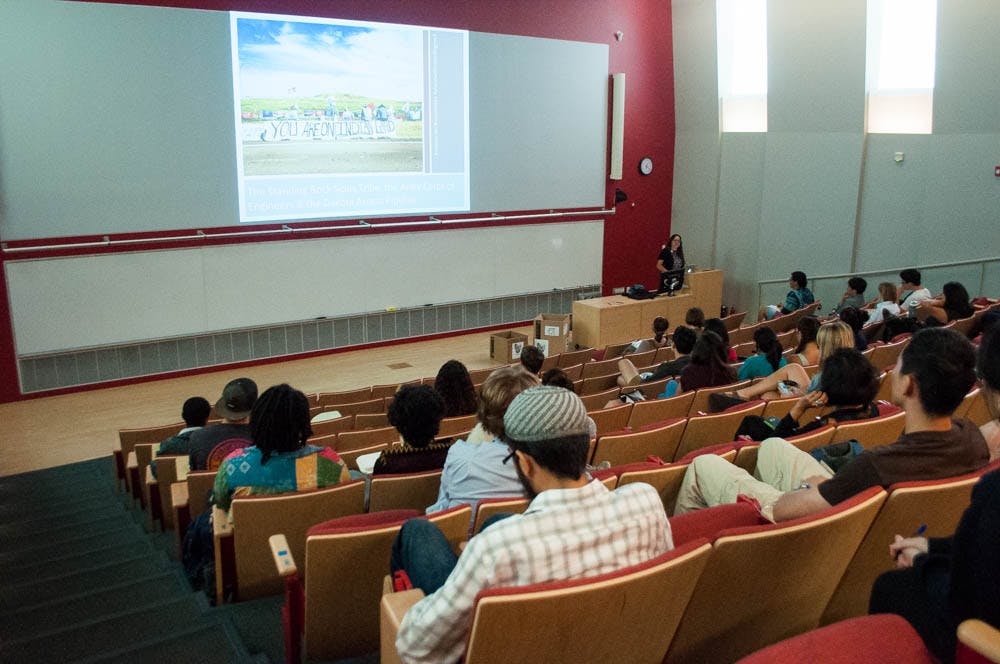Students gathered in Metcalf Auditorium Saturday afternoon for a teach-in on the Dakota Access Pipeline. Jennifer Weston ’97, who led the teach-in, spoke about the impact the pipeline has already had and could have in the future on the Native American land it would cut through.
Weston, who concentrated in ethnic studies with an independent focus on tribal government natural resource management, is a member of the Standing Rock Sioux Tribe. After welcoming the audience in her native language, Lakota, Weston framed her presentation as a timeline detailing the efforts of the Standing Rock Sioux tribe and its supporters to prevent the pipeline’s construction since January. The tribe would be directly impacted by the pipeline, which intends to carry 470,000 barrels of crude oil per day from North Dakota to Illinois.
If constructed, the pipeline could potentially contaminate Lake Oahe — a source the tribe heavily relies on for drinking water. Weston pointed out that the original plan for the pipeline routed farther north, but it was redesigned out of concern that it would leak into the water supply of Bismarck, the state capital. According to the Center for Biological Diversity, oil spills were the leading type of pipeline incident to occur in the United States from 1986 to 2013.
The pipeline was proposed by Dakota Access, LLC, a company under the umbrella of Energy Transfer Crude Oil Company, LLC, a Texas-based, U.S. Fortune 500 natural gas and propane company. In addition to putting the health and safety of those surrounding the pipeline at risk, the DAPL route runs through sacred tribal land and ancestral grounds, Weston said.
The DAPL survey and construction crews have brought alongside them armed security that has let loose security dogs and has maced and intimidated peaceful protesters and tribal members, including a line of women linked in arms and singing in prayer, Weston said.
Yet the members of Standing Rock Sioux remain peaceful and unarmed, and they engage in “nonviolent direct action,” Weston said.
Standing Rock Sioux has a longstanding history of protecting its land. In the 1950s, the Pick-Sloan Plan was approved by Congress, greenlighting construction of the Oahe Dam, which flooded thousands of acres of Standing Rock land, wrecking cropland, rangeland and vital species of plants and animals used for food, medicine and ceremonies, Weston said.
Today, though, Standing Rock Sioux’s fight to protect its land has gained traction with the broader public and fellow tribes. For example, citizens of various local tribes founded a spirit camp, Sacred Stone Camp, along the proposed route of the pipeline in April 2016. The site is “dedicated to stopping and raising awareness (about) the Dakota Access pipeline, the dangers associated with pipeline spills and the necessity to protect the water resources of the Missouri river,” according to the website.
In addition, the ACLU of North Dakota, Amnesty International and supporters worldwide have contributed legal and monetary aid in the past year.
“There’s been a tremendous coming together among tribal leaders, educators, attorneys and a lot of elected politicians, as well, that have issued warm and supportive statements about what they’ve seen on their visit to the campsite,” Weston said.
The militarization, arrests of peaceful protestors and urgency of the DAPL surveying crew have escalated in the past couple months, Weston said.
“The DAPL will affect millions of people if constructed and violate treaty rights and human rights — to clean water. This event was a way to bring that awareness to the broader Brown community who might not know what is going on,” wrote Niyolpaqui Moraza-Keeswood, coordinator of Native American and Indigenous Studies, in an email to The Herald. “Many of us aren’t able to go out to North Dakota in person, but that doesn’t mean we can’t do anything from afar to help.”
Weston commends the University’s efforts to support Native Americans at Brown and nationally. “As an institution founded on the tribal homelands of two indigenous nations, the Wampanoag and Narragansett, it’s gratifying to see the University finally hiring Native faculty (members), engaging in significant outreach to tribal communities and supporting its Native student population by incorporating academic coursework and research that builds upon our tribes’ ancient civilizations and linguistic connections in the Americas,” Weston wrote to The Herald after the event. Seeing the University invest in a substantive Native American and Indigenous Studies program is “a long-held dream for me,” Weston said.
The DAPL teach-in was co-sponsored by Native American and Indigenous Students at Brown, the Institute at Brown for Environment and Society and the history and American studies departments.





